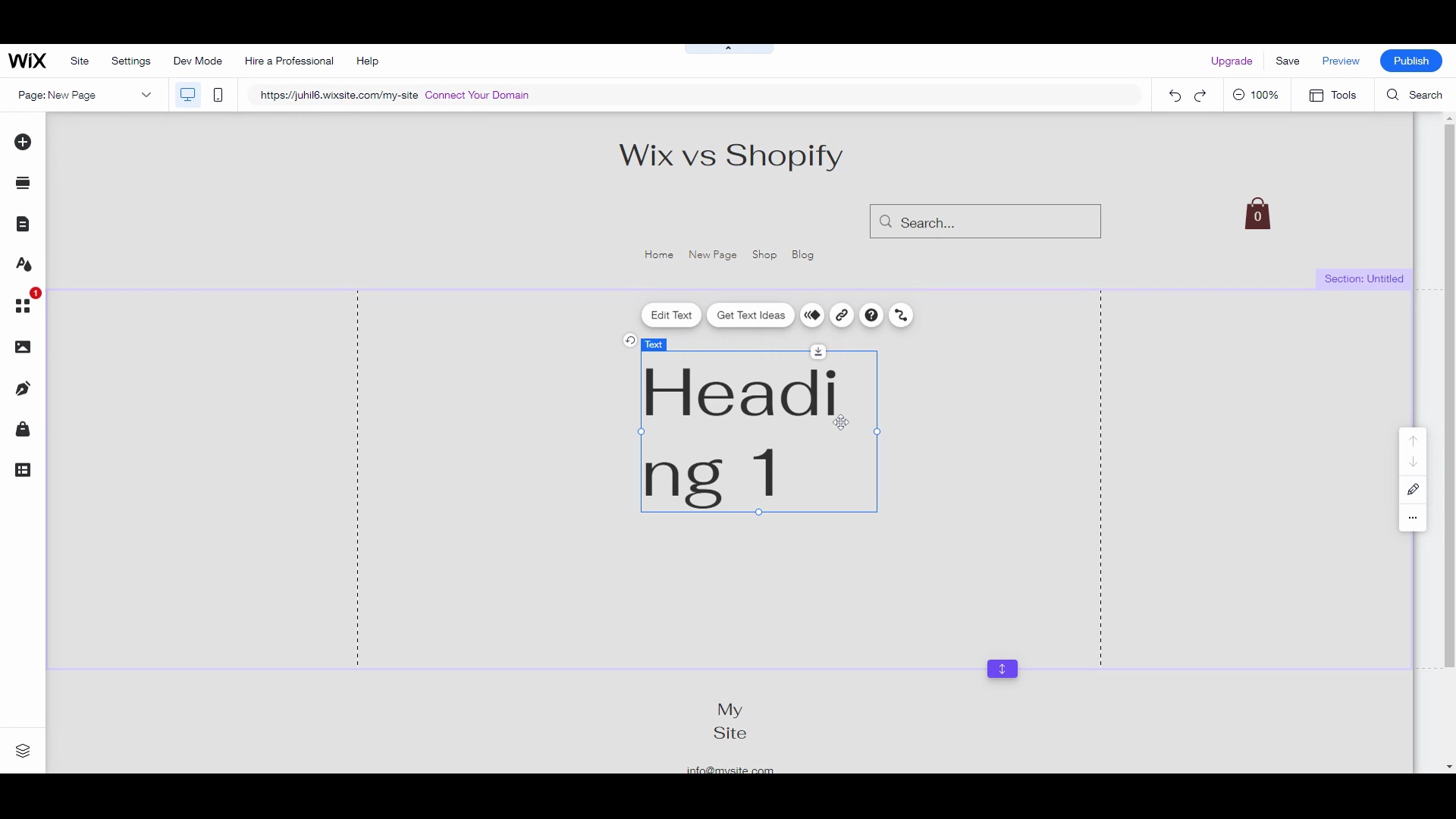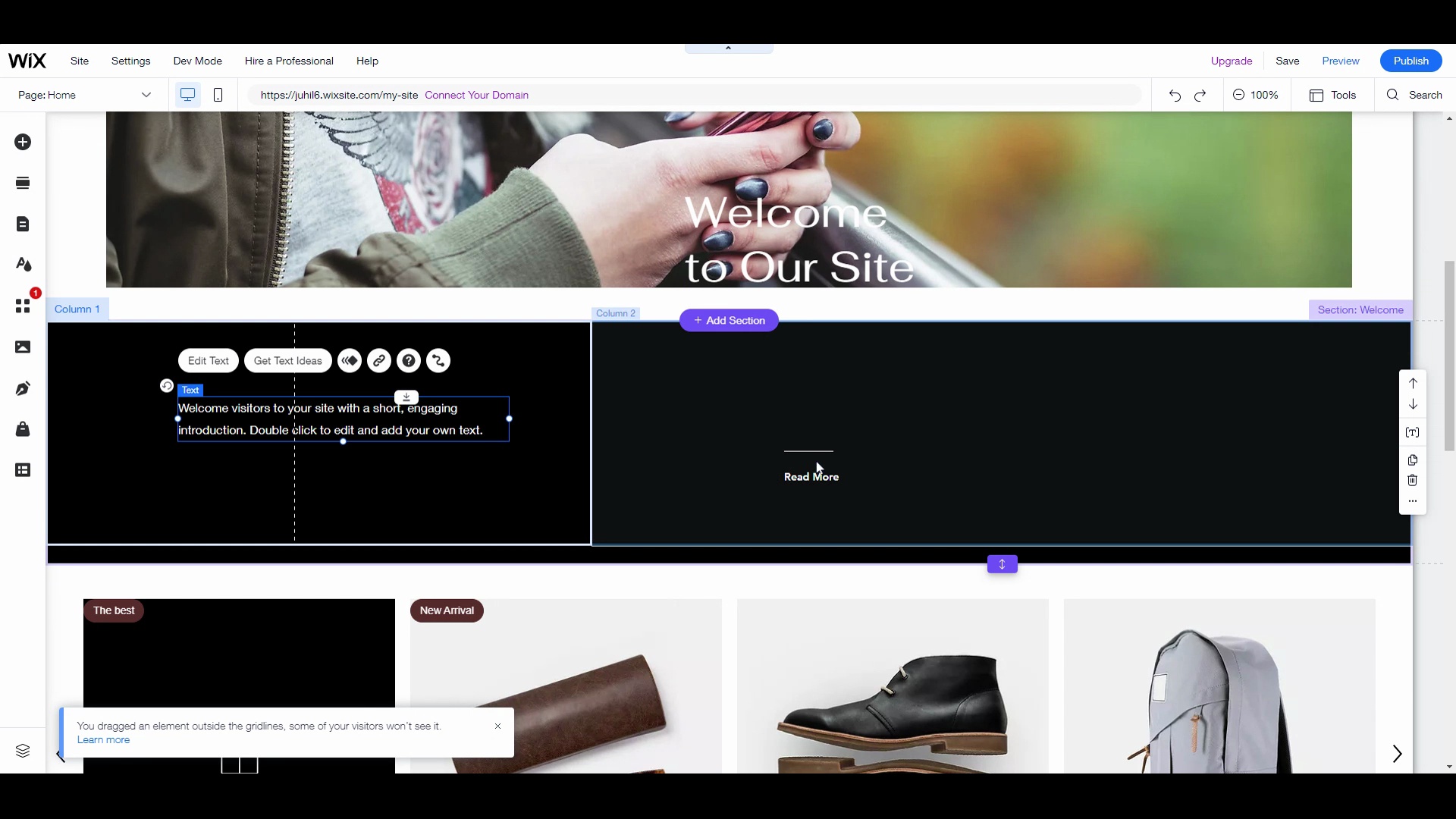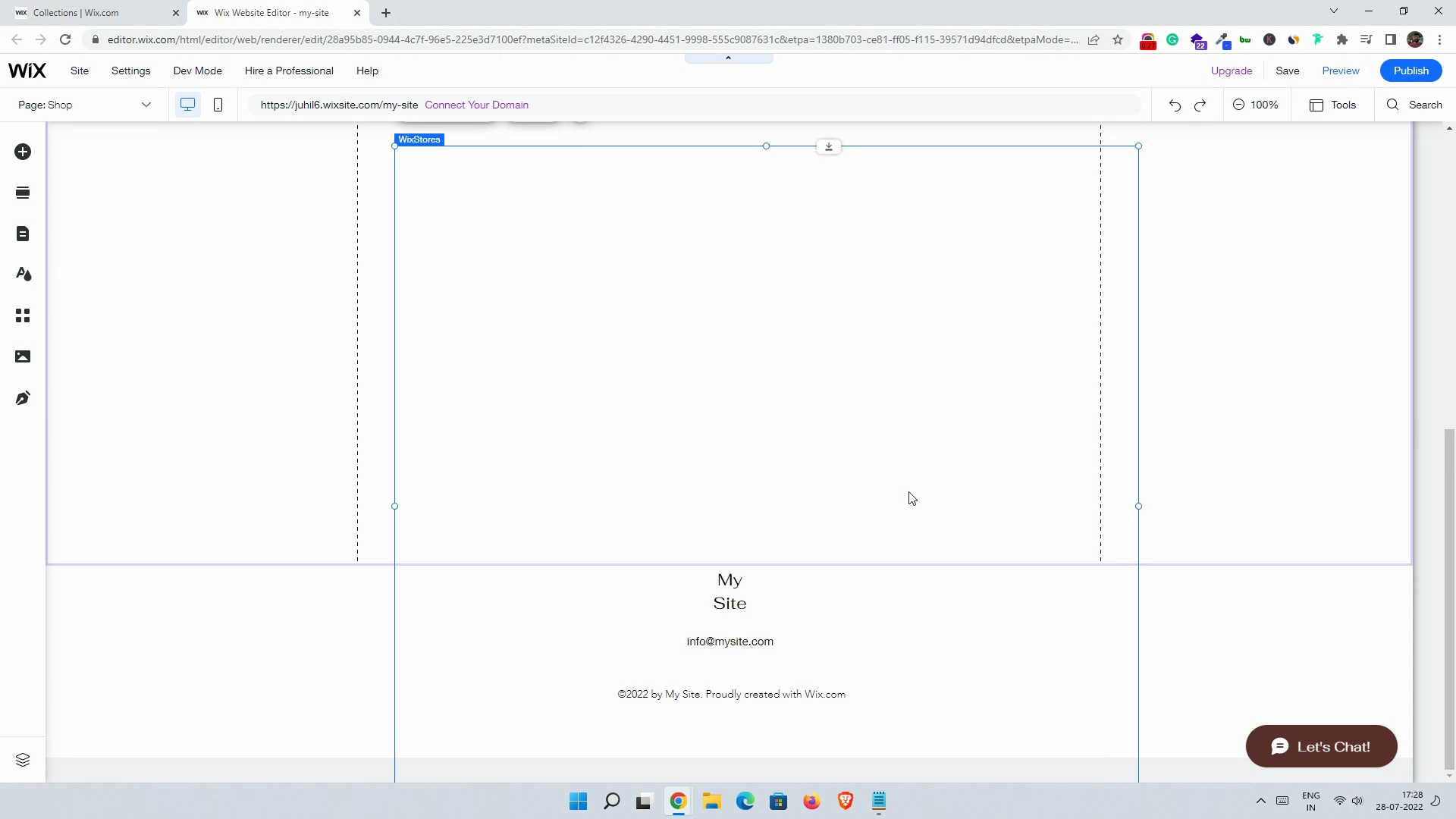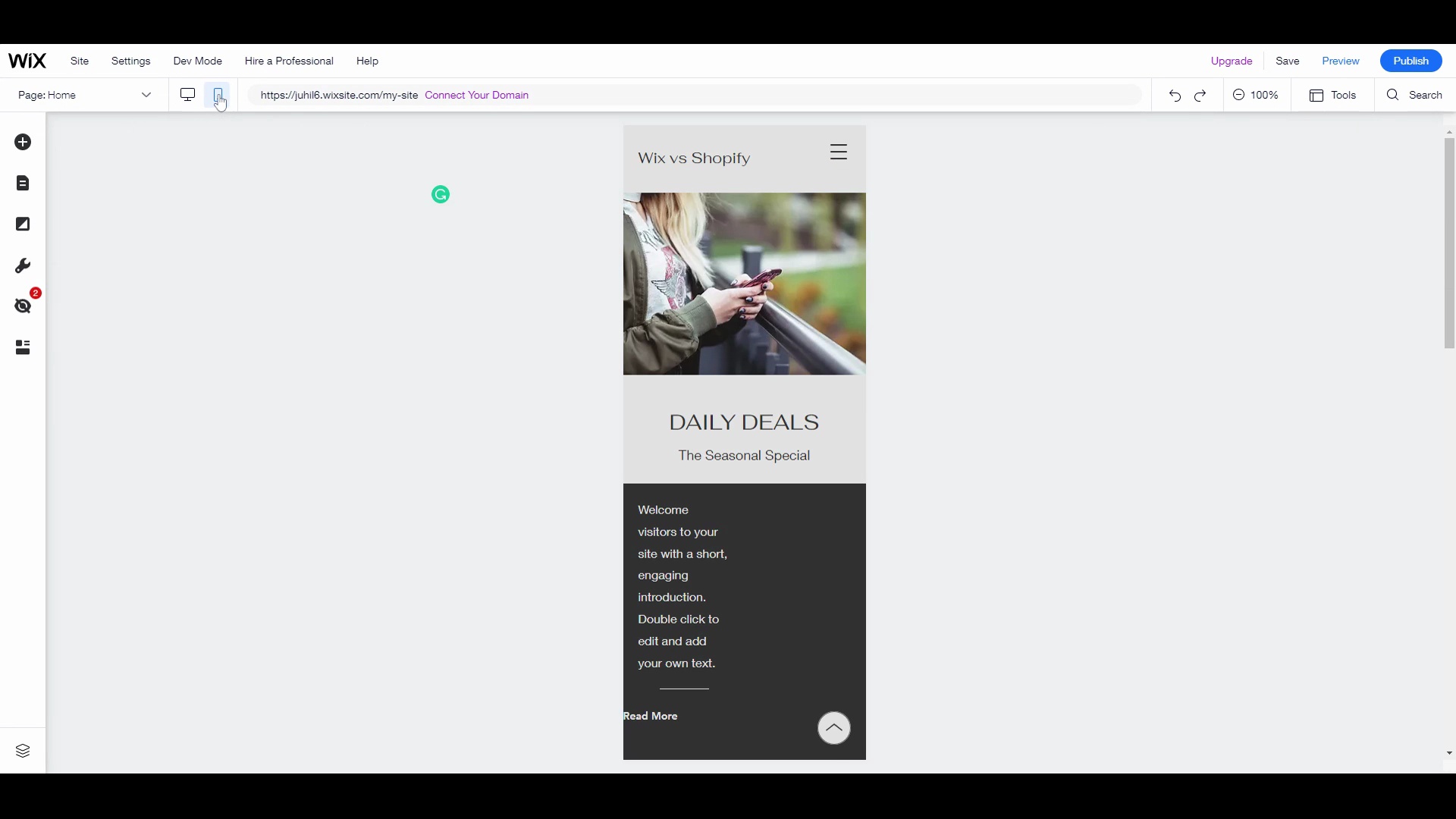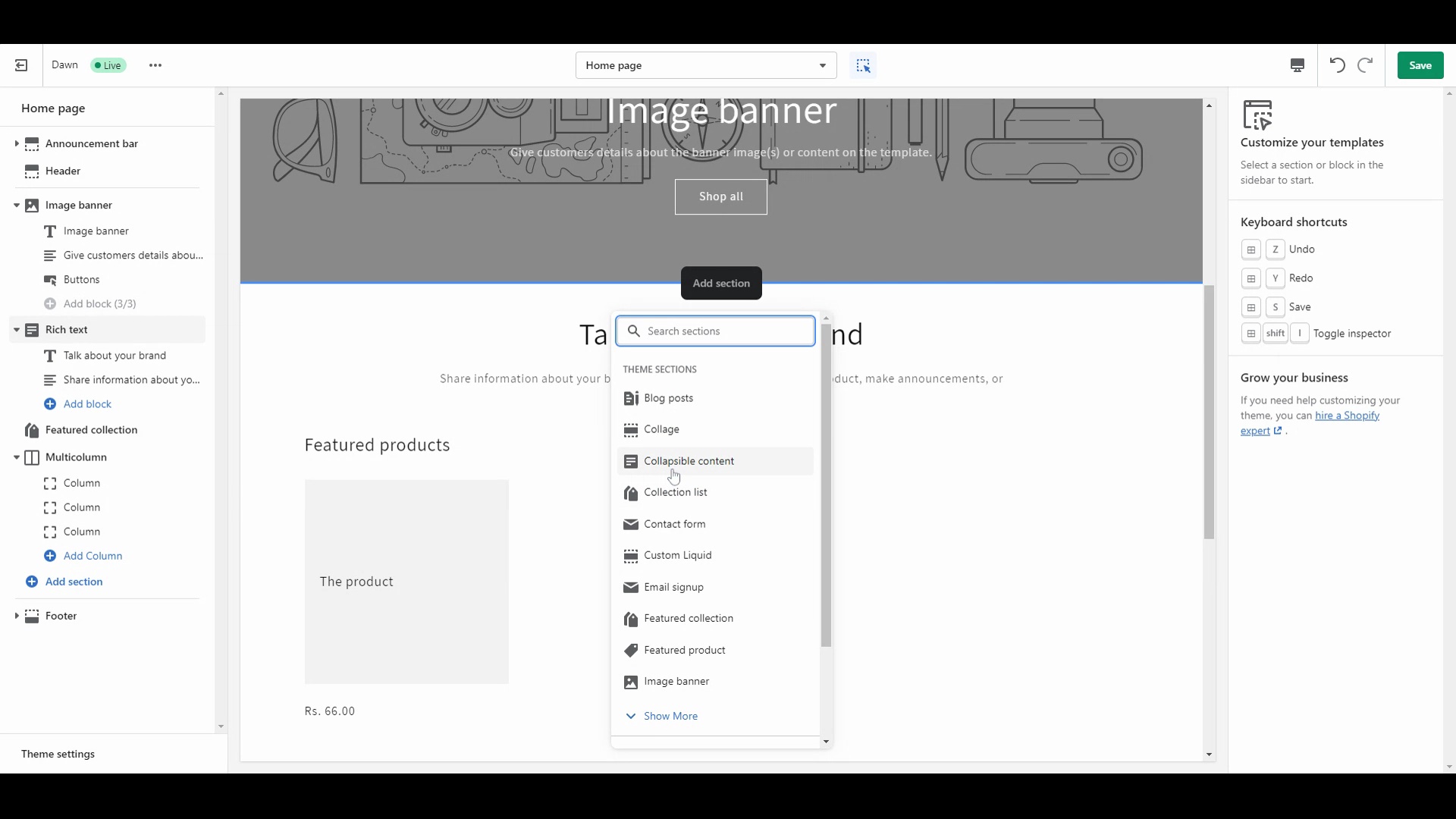Best Website Builder
I test every website builder so you don’t have to. These are my rankings of the best website builders in 2025.
Our work is supported by affiliate commissions. Learn More
By Juhil Mendpara | Fact checked by Steve Benjamins | Updated Feb 24 2025
Wix and Shopify are market leaders in two different categories — Wix is the most popular website builder, whereas Shopify leads the ecommerce builders segment.
But there are certain overlaps in the kind of websites you can make with both.
And that’s where the Wix vs Shopify comparison begins.

The types of websites you can make with Wix vs Shopify
I built online stores with both Wix and Shopify to find out how they solve the same problem (i.e., ecommerce). And I discovered some important differences — differences in the features-set, templates, editor, and the overall methodology of solving the problem.
This article will explain those differences to help you understand when to use Wix and when to use Shopify.
At its core, both Wix and Shopify are different platforms.
Wix is a website builder that has:
The “all types of websites” part is especially important when comparing Wix to Shopify.
Shopify solely focuses on ecommerce websites. In contrast, you can make an ecommerce website with Wix, but you can also make other types of websites - portfolio websites, photography websites, coaching websites, etc.
Note: If you are building a non-ecommerce website, you might want to look into our Wix vs Squarespace comparison.
Shopify is an ecommerce builder.
Shopify and Wix can indeed help build a similar website. But since they are different at the core, they have fundamental differences:
Wix has a visual, drag-and-drop editor. It’s unstructured, which means you can add anything anywhere on the web page, and it’ll fit there — pixel perfect!

The Wix page editor is fantastic for its flexibility, but it has two major downsides:
Compared to the Wix editor, Shopify’s editor is meh.
Shopify’s editor is similar to Microsoft Word — a rich text editor that lets you place images and videos in line with the text. Whatever you enter in the text editor adapts to your store theme.

The Shopify editor
Wix has over 800 templates in total and 132 templates for online stores.
Let’s stick to the online store website templates for this article.
All Wix templates are well-categorized across common online store categories - fashion & clothing, home & decor, arts & crafts, jewelry & accessories, etc.
And most ecommerce templates look modern and on par, unlike their website templates (This is because more than half of Wix’s online store templates were published in the last five years, i.e., modern times).
The best part about Wix templates is that they are free and easy to customize.

Wix Online Store Website Templates
Shopify includes 11 free themes and 114 premium themes across all ecommerce categories. That is a total of 125 themes on Shopify Themes.
In addition, many themes also have multiple different theme styles — if we consider those as themes too, Shopify Themes has over 300 official themes.

Four different theme styles of the Story theme on Shopify Themes
For the comparison, let’s just consider Shopify has 125 themes. In this case, Shopify has fewer online store themes than Wix. But…but…all Shopify themes are excellent.
Shopify really focuses on quality. When they moved to a new theme architecture recently, they removed many themes. Plus, at the same time, the company has been able to approve newer themes that follow the Online Store 2.0 guidelines.
In contrast, Wix has quite a few templates that give 2010 vibes (because they are from that time!).

Shopify Themes
Customizing your Shopify theme can be hit or miss.
The Shopify theme editor is structured and doesn’t give as much editing room as the unstructured Wix editor. Therefore, occasionally, you’ll need to edit HTML and CSS code to make your website look like you want to.
Wix is easier to use and has basic features to run a successful small store — but Shopify has much more sophisticated ecommerce features, making it an ideal choice for stores of any size. For instance, Shopify powers large ecommerce stores like Allbirds, Bombas, Kylie’s Cosmetics, etc.
I’d say Wix isn’t even in the same league as Shopify when it comes to ecommerce.
Shopify beats Wix at almost every ecommerce aspect - shipping options, tax settings, inventory management, customer management, sales channels, etc.
Shopify’s main competitors are heavyweight ecommerce builders like BigCommerce, Volusion, Magento, and WooCommerce. And among them, Shopify has risen to the top of this market over the last ten years:

Over the last ten years, Shopify has risen to become the industry leader. (2022 data)
You now know the fundamental differences between Shopify and Wix. Consequently, you might have concluded which platform to choose for your business. But wait…
Are you making the right decision? There are some devils in the details that you might want to know:
If you are choosing between Wix and Shopify, you are likely wondering about ecommerce features. You want to know about the shipping options, payment options, taxes, inventory management, products you can sell, etc.
Well, let’s go through them one by one to understand them better:
Wix offers very basic shipping options out of the box.
You can choose a region and add shipping rates based on the product, product weight, or product price. Also, you can choose to offer free shipping or flat rate shipping. If you are in the US selling in USD, you can set up real-time shipping rates with USPS.
Besides, you can allow local customers to select local delivery or local pickup options.
Shopify also offers every shipping option Wix offers - free shipping, flat rate, local pickup, local delivery, location-based shipping, weight-based shipping, and product price-based shipping.
On top of that, Shopify gives an option to enable third-party calculated rates at checkout. You can allow Shopify to dynamically add shipping rates based on FedEx, USPS, UPS, and Canada Post charges.
Moreover, Shopify has tie-ups with all these carriers to give you, a Shopify customer, discounts on the shipping rates — you can get up to 88% discount on DHL Express, UPS, or USPS.
Storing items in your guest room, packing them, printing labels, and manually shipping is all fun (and cheap!) in the initial days. Also, they sure make for good “I am hustling” Instagram posts.
But, practically, you’ll need to rent a place to store everything and hire someone as you scale; or you’ll need to opt for fulfillment service.
In 2019, Shopify launched its own fulfillment service called Shopify Fulfillment Network in the US. This means if you are in the US, you can let Shopify manage your end-to-end fulfillment, which includes inventory management, product storage, and delivery. We haven’t personally used it, but we found it’s more expensive than other 3PL or fulfillment services, + it lacks some fundamental features. But, no worries…
Shopify also integrates with many more mature third-party fulfillment services like ShipBob, ShipHero, Red Stag Fulfillment, Shipstation, Ship Monk, etc.
Wix doesn’t have as many fulfillment service integrations as Shopify. And those it does have don’t have any reviews or poor reviews:

Inventory management is central to any commerce business, whether online or offline. If you are understocked, you risk losing business. And if you are overstocked, the items can go bad/out of fashion, or you won’t have enough cash flow to run the business.
NOTE: You can add multiple inventory locations on Shopify. Wix doesn’t have that option.

Wix has basic inventory management features:

Shopify also has basic inventory features, including adding inventory, updating inventory, and automatically tracking inventory.
On top of that, Shopify has Transfers. Transfers help you track & record incoming inventory (from suppliers to your location as well as between your store locations):

You can also see the history of the transfers for each inventory item:

Unfortunately, Shopify doesn’t alert you if items run out of stock. You’ll need to install an app for it, and it adds to the business cost. For example, Notify Me app costs $5/month.
These apps, though, do much more than Wix’s on-dashboard notifications. For example, with Notify Me:
The Shopify App Store also has more advanced-level, enterprise-ready inventory management apps like Katana Manufacturing ERP. In contrast, Wix has no good inventory management app whatsoever.
Both Wix and Shopify have their own payment gateways: Wix Payments and Shopify Payments, respectively.
Besides, you can choose from many (local, national, and international) third-party payment gateways if you are on either platform. Wix allows 50+ payment gateways worldwide; Shopify allows 100+ payment gateways.
Note that Shopify charges between 0.5%-2.0% third-party transaction fees if you don’t use Shopify Payments. This can be expensive if you live in a country where Shopify Payments isn’t available. This YouTube comment illustrates a common scenario perfectly:

Wix has no such charges.
Wix Payments is available in 15 countries, including Austria, Belgium, Brazil, Canada, Finland, Germany, Ireland, Italy, Lithuania, Netherlands, Portugal, Spain, Switzerland, United Kingdom, and the United States.
If you use Wix Payments, you’ll have to pay payment processing fees that vary according to the payment method and the region. For example, the credit card/debit card processing fee in the US is 2.9% + 0.30 USD (which is typical).

Here are the processing fees for other countries. Wix Payments is an excellent option, especially if you plan on selling in EU countries.
Shopify Payments is available in 23 countries - Australia, Austria, Belgium, Canada, Czechia, Denmark, Finland, France, Germany, Hong Kong SAR, Ireland, Italy, Japan, Netherlands, New Zealand, Portugal, Romania, Singapore, Spain, Sweden, Switzerland, United Kingdom, and the United States.
Shopify charges between 2.4% + 0.30 USD and 2.9% + 0.30 USD in credit card processing fees in the US — the more advanced the plan, the lower the processing fees. This is one of the (less significant) reasons big-scale stores use Shopify.
Let’s understand it with a mid-sized ecommerce store example:
MrBeast’s Feastables store uses Shopify. The chocolate company made over $10 million in revenue. If the store were on the Shopify Basic plan (or any Wix plan), it’d cost the business $290,000 in payment processing fees. Comparatively, the payment processing fees would be $240,000 if it is on the Advanced plan.
That’s a $50,000 difference — MrBeast could probably make half a video (if he feels frugal) with that money!

The Shopify Payments processing fee is even lower for Shopify Plus stores (which most big stores are). Reportedly, Shopify charges Plus users only 2.15% + 0.30 USD per transaction.
The Shopify fees also change with the country. For example, Shopify UK charges a lower credit card processing fee: 2% + 25p for Basic users, 1.7% + 25p for Shopify users, and 1.5% + 25p for Advanced users. For comparison, Wix charges UK users a comparatively higher 2.1% + 0.20 GBP fee on all credit card transactions.
You can’t sell in multiple currencies with Wix. You can convert the currency according to the visitor’s location, though.
Shopify allows you to sell in multiple currencies with Shopify Payments. This means your customers can view prices in their currency, pay for their orders at checkout in their currency, and receive refunds in their local currency.
Wix’s tax options are as basic as they get.

However, if you are on Wix’s Business Unlimited or Business VIP plan, you can use Avalara’s automatic tax calculation system, AvaTax.
Avalara is one of the most advanced tax compliance software — they regularly update state and federal tax compliance data for a wide range of compliance types worldwide and automatically add accurate taxes to your invoices, so you don’t have to.
Unfortunately, the documentation around using AvaTax for Wix is unclear and, to some extent, deceptive.
We chatted with both companies’ customer support but couldn’t get precise information on how much you’d have to pay and how much is free, and what is free. From the limited information at hand, here’s what we understand:
The ridiculous rate for automated tax calculation alone proves why Wix isn’t for high-volume stores. Big stores easily cross 500 transactions each day, and there’s no way they’d want to pay $150 for tax calculations each day!
Shopify includes what AvaTax does for Wix by default (and for FREE!).
Shopify uses many default sales tax rates and updates them regularly, eliminating a lot of setup work. Also, you can override the default numbers if needed. Besides sales tax, you can also add “Duties and import taxes” for international orders, VAT, GST, and shipping tax.
Steve told me automated taxes is one of the main reasons he prefers Shopify over any other ecommerce platforms:
“Tax & automatic shipping estimates are the main reason I’m only ever using Shopify for stores in the future.”
News: Shopify recently launched its own advanced tax platform, Shopify Tax(which will be similar to Avalara soon). It’s not free, but no worries - you’ll always have access to the free legacy tax features we mentioned above; choose Shopify Tax when you absolutely need it.
You can sell pretty much anything with both Wix and Shopify (you may need to add an app, though):
And you can sell all these things through multiple sales channels, not only your ecommerce store.
A sales channel is where you sell your products or services, directly or indirectly.
Yes, you’ll build an ecommerce store with Wix or Shopify, but that’s just one channel. Both platforms have integrations that help you sell the same inventory on other channels.
You can use Facebook and Instagram sales channels if you build your store with Wix.
For an additional $200/month, you can also build your own branded app with Wix, i.e., people can download your mobile app from Play Store or App Store, and the app becomes a sales channel.
Shopify has comparatively more sales channels than Wix, namely Google channel, Facebook channel, Shop channel, Shopify Inbox (showcase products & sell while chatting with the customer), Buy button channel, Pinterest, TikTok, eBay, Walmart, Amazon, SMS, Lyst, JD Marketplace, Rakuten Japan, Handshake for wholesalers, MyDeal Australia, Whatsapp sales channel, Spotify for artists, and more.

Shopify sales channels
If you want to build a mobile app for sales, Shopify App Store has many great options: Plobal Apps (from $199/month), Shopney (from $99/month), Vajro (from $99/month), etc.
If you sell your inventory both online (through an ecommerce store, for example) and offline (through a retail store, in events, etc.), you’ll need a POS system to keep everything in sync.
Both Wix and Shopify have their POS software that you can access via their mobile or tablet apps.
Both have pretty much all the POS features you may need, including ones for omnichannel sales, syncing inventory in real-time, native payments, analytics, team management, data collection, etc.
And you can buy POS hardware from both — though Shopify is more lenient than Wix when it comes to POS hardware: Wix requires you to use only their hardware (The Complete Retail POS Package by Wix costs $850 — not cheap!), while only the Shopify card reader is mandatory to accept payments with Shopify POS.

Wix POS system
Besides the hardware restriction, Wix POS has geo-restrictions as well. Wix POS is only available to select US-based users!
In contrast, Shopify POS is available worldwide, and all Shopify users can use it.
On top of that, Shopify has a few advanced POS features as well. Though, those have more to do with its ecommerce platform than the POS system. For example, Shopify allows multi-location inventory (Wix doesn’t), so Shopify’s POS inventory management allows managing multi-location inventory.
Shopify’s in-person credit card rates start at 2.4%. Wix’s fees are slightly higher at 2.6%.
One thing Wix has going for it is Wix POS is completely free.
In comparison, Shopify POS has a free plan (Shopify POS Lite) that includes basic POS features and an $89/month per location paid plan with more advanced yet fundamental features related to inventory management, staff management, etc.
It becomes increasingly important to group your products well as your catalog size increases. After all, you want your potential customers to find what they are looking for as fast as possible.
Let’s take the most basic example to understand it better: If you sell clothing for both men and women, you must have a men’s and a women’s collection so that both parties don’t see unrelated clothing items.
Collections only get more complex from here — for example, say you sell seasonal clothes, then you should have a “Summer collection,” “Fall collection,” etc.
So the question is: How effectively can you make these collections with Wix vs Shopify? Well…
Creating collections in Wix is a manual and tiresome process. You have to create a collection and search & add each item you want in that collection.
In comparison, you can create two types of collections with Shopify:

Collection type - Shopify
Most ecommerce stores need to showcase product options/variants. For example, a typical clothing store product has size, color, or material options.
So, obviously, both Wix and Shopify allow users to add product options.
But Shopify has one major advantage over Wix:

You can only connect images to one option in Wix
Wix doesn’t allow connecting images to a combination of options.
Say you sell a jacket in multiple materials (ex: suede and leather) and colors (ex: blue and brow), you can’t show product photos dynamically for all four combinations (blue x suede, blue x leather, brown x suede, brown x leather) with Wix.
In contrast, Shopify allows you to connect relevant product photos to all combinations.
Both Wix and Shopify require you to add an app to collect product reviews. The only difference is there’s no fully free app for Wix.
Some of Wix’s plans include Product Reviews by KudoBuzz, but there are limitations:
Besides KudoBuzz, you can find a few other product review apps on the Wix App Market.
Shopify has its own completely free product reviews app, creatively named *Product Reviews*. It’s very basic, though. You are better off with other options available on the Shopify App Store. For example, Judge.me is a good free alternative. In addition, the Shopify App Store has some awesome, better-than-any-Wix-app product review apps as well, like Okendo and Junip.
Most dropshipping stores I come across are made with Shopify.
It’s because of these three obvious reasons:
Templates (and, in extension, demo stores made with them) tell a story about how your website will look and function. The templates also showcase what kind of & size of websites they are made for.
Here’s how Wix Templates compare to Shopify Themes — I compare them for the looks, the functionalities, and ease of use.
Wix has over 800 templates overall and 132 templates for online stores. They are free and easy to customize.
Because Wix has started to take ecommerce seriously only in the past few years, most Wix Templates are made recently and hence look modern. For example, Wix’s favorite T-Shirt Store Website Template is trendy and well-organized:

Wix’s modern online store template
However, I feel Wix likes to advertise the massive number of their templates (“We have 800+ templates”), so they don’t get rid of arguably dated templates. For example, this Wix template would be considered good…if it were 2010(!):

If you look through all Wix templates, you’ll notice a pattern (in its features) that points you to one conclusion: Wix is only good for small stores.
For example, many Wix templates (like the “trendy” t-shirt store template) don’t even have a search bar embedded in the header.
My interpretation of it is this template looks best/is for stores that don’t require a search bar, i.e., stores with so fewer products that visitors can look at them all in one scroll or a couple of clicks. [You can externally add the search bar by adding the “Wix site search” app.]
Besides, I noticed Wix templates don’t have/have subpar mega menus, detailed product filtering, live search, etc. These features are necessary to build high-converting large catalog stores.
Wix has a drag-and-drop, visual, unstructured template editor. It gives you a lot of control over the theme of your choice.
You can add/remove/edit/move sections and blocks anywhere and everywhere on the webpage. For example, here, I added a “Welcome” section and moved its text blocks to multiple places, and they fit there pixel-perfect:

I added a section, moved its text block here and there
It’s great from a customizability point of view, but it brings two major disadvantages:

I tried to add a collection on a page, and the Wix editor added it on top of other things instead of creating a separate section.

Here’s how the same section looks on mobile — messed up!

Besides the drag-and-drop editor, Wix also has Dev Mode (Velo by Wix) that lets you make custom edits through code. For example, if you want to animate a transition on your website, you’ll need to edit code — a drag-and-drop editor won’t do.
Shopify has 125 verified themes. Eleven of them are free. And the paid themes have a one-time cost of anywhere between $180-$350. (You can also choose from thousands of unverified, third-party themes — more on it below.)
All Shopify Themes are mobile responsive.
You can explore all the themes by the features, catalog size they’re meant for, theme category, etc.

Filter Shopify Themes by catalog size
Each theme is fresh, modern, and sophisticated. And each theme follows the UI best practices for ecommerce stores. For example, this theme is free and comparable to Wix’s T-shirt store theme (and this one has a search bar by default!):

The ‘Sense’ theme
The Sense theme is for small stores. But Shopify also has powerhouse themes that suit big catalogs (200+ products) and high-volume stores well.
For example, the Canopy theme is one of the top-listed themes under the 200+ catalog size filter:

And everything about it hints it’s meant for big stores. For instance:

‘Canopy’ theme’s search bar
The ‘Shop’ dropdown mega menu helps navigate to categories and subcategories:

There are thousands of Shopify themes created by 3rd party developers.
These themes cost money and rely on the 3rd party developer to provide support, but there are lots of examples of live Shopify stores that look beautiful.
When it comes to 3rd party Shopify themes, there are two classes: verified providers and unverified.
Shopify includes a Customizer tool for customizing themes. It’s structured (unlike Wix), and you can add sections and blocks to it and move them up or down essentially:

Adding a section and changing block position on Shopify Customizer
Unfortunately, the Customizer tool is very limited. You can do basic things like changing the heading size between small, medium, or large or choosing how many columns you want for displaying the products.
You’ll need to jump into code to make most changes. For example, the only way to change the navigation text color is to edit the CSS code.

Shopify’s code editor
Here’s a rule of thumb: If you want a custom Shopify theme, you’re not going to be able to do it without jumping into CSS code occasionally or hiring a Shopify theme expert.
Note: This section likely doesn’t concern you.
You can fully customize your Shopify theme or build a whole new theme for your store with Shopify Liquid API. Liquid is a template language created by Shopify. All Shopify themes are built on top of it.
A website builder’s page editor plays a huge role in its “ease of use” and “development time” factors.
For some, these factors are more important than extensive ecommerce features. For instance, an artist wanting to sell his paintings online will be happy with basic ecommerce features if he can easily build and manage his own website.
And for them, Wix makes a lot of sense because of its beginner-friendly page editor.
Wix’s page editor and theme editor are the same — you can edit any Wix page with its easy-to-use drag-and-drop editor.
On top of the user-friendly editor, Wix has many well-designed templates of commonly-used pages - About, Services, Landing page, Contact, Blog, etc. You can start from them and quickly edit and publish.

Wix’s pre-made About page templates
Wix’s drag-and-drop editor is its main editor and one most people mean when they say “Wix Editor.” But Wix has two more editors:
Shopify’s editor is similar to Microsoft Word — it’s a rich text editor that lets you place images and videos in line with the text. Whatever you enter in the text editor adapts to your store theme.

Shopify's WYSIWYG editor
This isn’t as intuitive and as flexible as the Wix editor. Therefore, making a beautiful page with the default Shopify page editor is hard.
Note: You can use a page builder like PageFly, Shogun, or Gempages to build beautiful Shopify pages.
A product editor is different from a page editor (and theme editor). A product editor is where you add information that shows up on your product page or helps with product organization.
Both Wix and Shopify product editors have primary features: You can add the product name, product description, media, price (MRP and sale price), product variants (size, color, etc.), inventory details, shipping details, brand name, collection, and SEO details.
But Shopify product editor has a few more features that makes it superior:


In Wix: You have to save product page edits, go to the homepage, preview the whole site, find the product you edited, and see it to find how the edit you made looks/work.
On top of it all, Shopify continues to make its editor better. For example, Shopify recently launched native support of complementary products. A comparatively tiny update like this helps store owners save hours of time:

Any kind of online business, especially ecommerce, needs marketing to achieve business goals. And both Wix and Shopify have a suite of marketing features.
Wix has a separate entity for marketing features. It’s called Ascend.
Wix Ascend is a collection of marketing tools and add-ons. You get limited access to it with your website plan and will need to upgrade to use it fully. Plans start at $10/month.

The free Ascend plan has 5000 emails and 3 email campaigns per month limit, for example.
Here are some of the tools included in Wix Ascend:
Though most of Wix’s marketing-related features come under Ascend, you have access to some features out of the box:

Wix Blog Post Editor
You can add third-party marketing apps to your Wix site through Wix App Market. It has niche apps for email marketing, SMS marketing, popups, affiliate marketing, upselling, and more.

Shopify chooses a similar route as Wix in presenting its marketing features, though in different packaging.
Firstly, Shopify — like Wix — has basic marketing features pre-installed on the platform: a good blogging platform (see Shopify blog examples to see how other Shopify stores are using it), announcement bar block, essential SEO features, etc.
Everything other than that is borrowed from a separate entity — the separate entity in Wix’s case was Ascend; for Shopify, it’s the Shopify App Store.
You can install Shopify’s own marketing apps as needed. Most of them are free or freemium. Here are a few of them:
However, these apps are subpar compared to the goldmine Shopify has in the form of third-party apps.

Shopify’s third-party apps give you access to any ecommerce marketing feature you need (most good apps are paid):
These are just a few of the top marketing apps on Shopify. Shopify has 1600+ of these listed!
Wix and Shopify allow third-party developers to make apps for their platforms. I already mentioned a few of them, especially the ones for ecommerce marketing. Let’s see what more both platforms’ app stores have to offer.
Wix App Market has a total of 300+ apps — only a portion of them are meant specifically for Wix Ecommerce. They are divided into categories like Marketing, Sell Online, Services & Events, etc., and subcategories like Conversions, SEO, Email, etc.

Shopify’s App Store is in its own league — not only when compared to Wix but any ecommerce platform.
The Shopify App Store has over 7500 apps (!) across categories like store design, marketing, merchandising, conversion, store management, fulfillment, customer service, shipping, etc.

Number of apps: Shopify vs Wix & others.
The apps on Shopify App Store are not only superior to Wix in width but also in depth.
Let’s talk about width first. Shopify App Store has a wide range of apps, many of the types (and with features) you won’t be able to find in the Wix App Market. For example:
Regarding depth:
You must track KPIs (Key Performance Indicators) like AOV (Average Order Value), conversion rate, cart abandonment rate, LTV (Lifetime Value), etc., to know the results your efforts produce and make informed decisions.
Both Wix and Shopify have well-rounded analytics platforms. Is one better than the other?
Wix provides in-depth analytics into sales, traffic, customers, and more.

Analytics & Reports you can see on Wix
You can see reports of
Shopify has a mature analytics platform that shows and reports important ecommerce KPIs.
You can see these metrics on the Shopify Analytics overview board: Total sales, Online store session, Returning customer data, Online store conversion rate, Average order value, Total orders, Top products by units sold, Online store sessions by traffic source, Online store sessions by location, Online store sessions by device type, Online store sessions by social source, Sales by social source, Sales by traffic source, Top referrers by sessions, Top landing pages by sessions, and Sales attributed to marketing.

Analytics dashboard of Steve’s Shopify store
Under its Reports section, you can find in-depth reports on sales, acquisition, orders, profits, and pretty much all dimensions I mentioned above.
Compared to Wix, Shopify offers more insights for ecommerce businesses. For instance:
How optimized and feature-rich a website builder’s mobile app is should probably be the last thing to affect your platform choice. Most people use it just to see analytics or do basic edits. I know many Shopify users, in specific, keep the app for just the dopamine-pumping cha-ching notifications.
But both Shopify and Wix have invested quite a bit in their mobile apps. So how do they compare?
Firstly, Wix has numerous mobile apps: Wix Owner, Spaces, Fit by Wix, Dine by Wix, and Wix Logo Maker. I am focusing on the Wix Owner: Website Builder app.
Wix’s mobile app is available for both Android and iOS devices.

Wix mobile app screens, as seen from my Android phone
Apart from making or editing the web pages, you can do everything on the Wix app:
Shopify has an Android and an iOS app.

Shopify mobile app screens, as seen from my Android phone
Because its page editor isn’t unstructured like Wix’s, you can create and edit web pages as well. That’s the main difference between the Wix mobile app and the Shopify mobile app.
Besides, it has all the ecommerce-related features Wix’s app does: You can set up your store, add products, add apps, make design changes, publish blog posts, see analytics, and pretty much handle your whole business from the Shopify mobile app.
The importance of online security for ecommerce businesses cannot be overstated. One mishap and the whole business comes crumbling down.
How well would Wix and Shopify — both closed platforms — handle your store’s security? Short answer: Well enough (and then some). Long answer:
Wix does everything in its power to keep your site secure:
Wix gives you access to all manually-saved versions of your site. You can look at the site history and restore any revisions.

Select any site revision to restore
Unfortunately, you can’t restore data saved inside apps; only customization and design changes are reverted back. Let’s understand it better with an example: Say you made product detail changes in Wix Stores. You won’t be able to restore the previous product version data with Wix.
Note: No third-party app on the Wix App Market takes fully automated backups.
Shopify is similar to Wix in security regards. They add SSL certificates to all stores, are PCI compliant, and have systems in place to avoid security disasters.
One of the biggest threats for a platform like Shopify (that heavily relies on third-party apps) could be the vulnerabilities third-party apps bring. But fortunately, as long as you install an app from the Shopify app store, you are safe. Shopify has strict security requirements for developers submitting apps.

Shopify App Store's security requirements from developers.
Shopify also has a bug bounty program. Since its launch in 2015, security researchers have reported 1400+ bugs, and Shopify has resolved them.

Shopify performs platform-wide backups, but it cannot restore your individual account data. You’ll need to rely on an app like Rewind if you want peace of mind.
Rewind costs start at $39/month, which is expensive, but it’s value for money. Rewind continuously backs up your entire store, including all items, images, product descriptions, blogs, themes, orders, pages, customer lists, and more. As I already mentioned, there’s no such feature or app in Wix.
Wix and Shopify come neck and neck when it comes to customer support. Both reply reasonably fast and have similar support options.
Wix has an extensive help center with articles related to common customer questions regarding getting started, Wix editor, billing, Ascend, mobile editor, site performance, Wix Stores, Wix ADI, Editor X, and more. There’s also a Wix Forum Community where Wix users help each other.
Besides, you have 24/7 access to their customer support via live chat and email.
You can also request a callback from the support team. Depending on the language you speak, phone support is available 24/7 or within specific working hours.

Wix’s callback operating hours
Shopify has solid help center articles and video tutorials for solving frequently asked questions. Then there’s the Shopify Community — with over 900,000 Shopify merchants and partners — ready to help you.

Shopify Community already has over 50,000 discussions
For the “talking to an actual human” aspect, Shopify covers all three main channels 24/7: live chat, email tickets, and phone support.

By now, you know Shopify is a superior ecommerce platform, and Wix lacks quite a few primary ecommerce features. Does it translate in both platforms’ pricing, i.e., does Wix cost less than Shopify? Well…decide for yourself:
Wix has one very limited free plan, eight paid plans, and enterprise plans. The eight paid plans are divided into five Website Plans (these plans do not have ecommerce features) and three Business and eCommerce Plans. For this article, I am focusing on the Business and eCommerce Plans to keep the comparison fair.

Wix’s annual plans:
There’s no free trial on Wix’s premium plans. However, you cancel the plan within 14 days of purchasing to recieve a full refund.

We talk about Wix’s website plans here. They start at $16/month (if we exclude the limited Connect Domain plan).
Shopify has five plans in total: Shopify Lite, Basic, Shopify, Advanced, and Shopify Plus. Each plan includes all major features, unlimited products, unlimited bandwidth, fraud analysis, and support.
All Shopify plan come with a 3-day free trial (no credit card required), plus then you have to pay just $1 for the next three months, which is more than enough to explore the platform and build your store on it.
The real plan pricing starts after.

Shopify’s annual plans:
The way Shopify has structured its platform, you’ll inevitably need to add apps to your store. The basic ones are free and from Shopify itself, and they are good enough for most new stores.
However, you’ll need to add third-party apps to your store as you scale. These third-party apps can quickly add to the business costs. Typically, beginner-level stores invest between $50-$100 per month on Shopify apps, but the number can go in hundreds or even thousands depending on the size of the business. For example, this Reddit user spends $1200 per month on Shopify apps:

You can learn about all Shopify store-related costs here.
Firstly, I would only ever recommend Wix’s ecommerce platform for small stores (for numerous reasons discussed above).
I can think of two good reasons to choose Wix over Shopify for your ecommerce website:
There is one really good reason to use Shopify instead of Wix: Shopify is a complete ecommerce platform and much more powerful.
This makes sense, really: Shopify is just for ecommerce websites. Wix is for general websites. So Shopify as a company will always be more focused on ecommerce features.
Wix lacks basic ecommerce features and barely touches any advanced ecommerce features. In contrast, Shopify is a fundamentally-solid ecommerce platform in itself + it has an app store with 7,500+ 3rd party apps that extend your store features.
It depends on the criteria:
Yes, Wix is easier to use than Shopify. It has a drag-and-drop editor that makes building a website very straightforward. A lot of what you can do with Wix editor can't be done with Shopify unless you know to code.
Firstly, not everyone prefers Wix (especially for ecommerce). But Wix surely is easier to use and a well-rounded platform for many types of websites, including small ecommerce stores.
Depends on the use case.
For a feature-rich ecommerce store, Shopify is better than Squarespace & Squarespace is better than Wix.
For a beautiful website, Squarespace is better than Wix & Wix is better than Shopify.
